
We are thrilled to be launching our first newsletter and blog at long last and at the end of a really busy year. We always have a number of long term projects on the go, and alongside these, some slightly more unusual ones that are worth a mention.
January opened with the arrival of the iconic Jann Haworth pop art Cowboy from Pallant House, Chichester, for emergency repair before loan. Along with a thorough surface clean, a number of structural repairs to the clothing and a redistribution of the stuffing, Hazel created a harness to help better support the Cowboy in his nonchalant pose against the wall.
January also saw the return of a Crimean war quilt to Tunbridge Wells Museum, having been touring since its display in The British Folk Art exhibition at Tate Britain. The stunning quilt, believed to have been hand sewn by wounded soldiers in the 1850’s, was constructed out of thousands of tiny shapes of wool cloth, possibly cut from their uniforms. We had conserved and mounted the quilt in 2014, with the mount board specially designed by Geoff with its return to Tunbridge Wells in mind; while the doors of Tate Britain were large enough to allow the mounted quilt to pass safely through, this was not the case at the much smaller Tunbridge Wells Museum. The mount board was designed to fold down the centre, thus reducing the size and allowing for easy passage, with the quilt still attached.
With February began a steady flow of tapestries coming into the Studio which continued throughout the year. The first were a set of seven panels, The Holy Trinity designed by John Piper for Chichester Cathedral and woven at Aubusson in France in the 1960’s. These were brought into the Studio for surface cleaning, shortening, relining and new Velcro. With their jewel-like colours restored, the panels were reinstalled on Easter Saturday for the big reveal at the service on Easter Sunday. This timing left little room for error and we had to make absolute certain that each would hang correctly and evenly against the carved screen behind the High Altar.
Natalia and Mira both worked on beautiful costumes designed by the iconic Charles James for Brighton Museum and part of the Messel Family Dress Collection. Natalia re-mounted an evening dress worn by Anne, Countess of Rosse in 1938, following the famous US Vogue photograph by Horst for inspiration. Mira conserved and mounted the ‘Spider wrap’ cape, designed by James a year earlier and made from an unusual cellophane based fibre.
As part of her Icon/HLF funded internship Mira had been working on a number of smocks from Worthing Museum and in April, Zenzie and Mira ran a care and conservation of smocks training day at the Museum for museum professionals and volunteers in the south east area. The day covered the history, construction and decoration of smocks as well as their safe handling, storage and display. Talks were illustrated by the conservation Mira had undertaken and raised awareness about the particular issues relating to waterproofed smocks which become extremely fragile with age. Mira also designed and made a supportive smock hanger which was taught to the participants. It proved to be a hugely enjoyable day for all with much positive feedback and we hope we can repeat the training day elsewhere.
At the end of April, we, like everyone else, were shocked to hear about the terrible fire that ravaged National Trust (NT) property Clandon Park – it was particularly devasting for us as we had spent more than a year conserving the textile elements of the beautiful Onslow State Bed. Although the bed structure has sadly been lost along with much of the contents of the house, in a wonderful twist of fate we had returned to Clandon a few weeks before the fire and taken the conserved quilted counterpane off display and packed it into the crates still containing the conserved curtains. These crates together with most of the matching suite of seat furniture were rescued by the Fire Brigade. Late that night Mira spotted images of our crates online, being carried across the lawns to safety and texted us with the news which was at least a small consolation for the tragedy. Hopefully the bed can be re-built one day to display these stunning textiles again.
Click here for updates on Clandon and a link to the Clandon Park appeal.
We were also back at Arundel Castle to take down one of the large Gobelin tapestries, ‘Le Chameau et L’Elephant’, part of the Nouvelles Indes series, featuring exotic animals, plants and peoples of Brazil that hangs in The Baron’s Hall. Originally woven as a set of eight for the ballroom at Norfolk House, London in 1754, there are currently four of the altered set remaining at Arundel Castle.
Access to the tapestry measuring 6.6m x 4.2m was high up in the rafters of the hall, via a three level scaffolding built for us to work safely from the balcony level. This made for a tight squeeze whilst carefully manoeuvring both handling roller and tapestry. We gradually rolled the tapestry off the wall with the roller mounted onto a special track and wheels designed by Geoff which allowed the vertical roller to rotate smoothly as the trolley moved along the track on the lower level of the scaffolding. It required six conservators plus Arundel Castle staff on the ground to safely roll up and lower the tapestry off the balcony. Once at ground level the tapestry was documented, surface cleaned and packed for sending to De Wit in Belgium for wet cleaning.
In the beginning of June we finally finished work on two door hangings and a smaller textile panel which were part of a 19th century Kiswah, the decorative cloth that covers the Kaaba in Mecca, Saudi Arabia. These appliqué panels are made up of coloured silk heavily embroidered in gold and silver Koranic texts onto a cotton backing fabric, measuring more than 3m x 2m each.
While the brief for these objects was fairly typical – to conserve and mount for storage and display – the size, the weight and crowded, 3D nature of the embroidery gave interesting challenges along the way. Even simply turning a panel over required at least five people to be available to help or the work ground to halt. Reaching the centre of each panel to apply Velcro was overcome by stitching the Velcro on whilst they were suspended hanging. This still required two people, one directing the needle from the front, and the other receiving the needle from the back and returning it, with a lot of verbal, “over to me, over to you, up a bit, down a bit”!
The mounts were also challenging as they needed to be made of inert material, be rigid and strong enough to support the mighty weight of each panel and yet light enough to be able to be moved and lifted with the panels in place. This was made possible thanks to some clever engineering and a good knowledge of modern materials by Geoff.
And as one large project left another immediately came in, in the form of the NT Kedleston Hall State Bed tester. This was a slightly more unusual project as we were tasked with finding a way to safely cover the original faded silk of the tester with replica silk without fixing into or damaging the original. We are working in tandem with furniture conservation workshop, Tankerdale and will post more about our treatment in the next year. Kedleston Hall are coming to the end of a huge conservation project and the bed will be reinstated in 2016. Click here for the National Trust video for more on the Kedleston Bed Project.
Our Icon/HLF intern Mira finished her internship at the end of June, a year that went by in a flash. After presenting her poster of her year with us at the Icon/HLF interns end show, and another poster on her work on the Palace of Westminster textiles, accepted for presentation at the Icon Textile Group Forum, Mira took a well earned holiday back in Finland before returning as a permanent member of the team in August.
We also took on another full time member of staff in the summer, Ania, who had first come to us as an intern from the Academy of Fine Arts, Warsaw, in 2012. She went back to Warsaw in September as part of the panel at the IIC Students and Emerging Conservators Conference to talk about her experiences of training in Poland, an Erasmus term in Finland and internships at home and abroad, which led to her subsequent position with us.
Click here for a link to the recording of the conference.
It was also that time of year for our Palace of Westminster project to get underway. This was the third year of the project, working with their Collections Care Manager Caroline Babington and a team of student conservators to carry out surface cleaning, lining and mounting of the collection of modern tapestries and textiles on display at Portcullis House. Interviews were held at the Centre for Textile Conservation at Glasgow University and Lincoln University in April and four were selected to work for four weeks in August during the parliamentary recess (Annika Amundson, Mary Evans, Freya Gabbutt and Jamie Robinson). This year’s objects included five felt panels by Helen Yardley and two tapestry panels by Allegra Hicks.
One of the Helen Yardley panels had been previously researched and conserved by Mira as part of her internship and this helped inform the student treatment of the five other panels. Zenzie and Natalia shared the teaching and supervisory role assisted by Mira and Helen Yardley came in to talk to the students who also visited her lovely East London studio
As always the project provides a wonderful opportunity for the students to experience working in situ in the heart of government in Westminster on their fascinating modern textile collection. The students were a joy to work with and it was a pleasure to help develop their skills. Click here for the Centre for Textile Conservation’s blog for more on the students experience of the project.
The summer also saw the Arundel tapestry onto the frame for a full linen support.
In September, the Studio began work on an exciting project from Westminster Abbey, where the new Queen’s Diamond Jubilee Galleries are being built in the Abbey’s medieval Triforium. The first of the textiles, three tapestry panels by William Morris came into the Studio for treatment.
Extremely dusty and sooty, the colours of these beautiful tapestries gradually emerged vibrant, hugely benefiting from very thorough surface cleaning. In January we will start work on the Funeral Effigies – watch this space!
The autumn saw the treatment of six tapestries from the Henry Moore Foundation. These stunning tapestries were designed by Henry Moore and woven at the West Dean Tapestry Studio in the 1970’s and are normally displayed in the Aisled Barn at the Henry Moore Foundation in Perry Green, Hertfordshire.
A large chunk of November was devoted to the preparation and presentation of an adhesive techniques workshop for French textile conservators, hosted in Paris by the Institut national du patrimoine. Zenzie and Natalia taught the course in English with translation very skilfully provided by Susanne Bouret. It was a stimulating, busy three days combining talks and practical work with lots of discussion and exchange of information.
Towards the end of November we finished the support stitching of the Arundel tapestry and took it off the frame ready for lining.
We also squeezed in the wet cleaning and display preparation of an interesting late 19th century Omdurman military flag given to Sir Winston Churchill. Minny and Zenzie installed it at NT Chartwell on 10th November just before the exhibition, Into the Trenches, opened to commemorate 50 years since the death of Churchill.
We also spent a dusty few days at NT Knole taking down part of the Caffoy wall hangings from the Cartoon Gallery. This was the culmination of many hours of documentation and mapping the position of each of the 50 or so patches that had been gradually added to the wall hanging over the centuries by the Sackville family. The highlight of this was the uncovering of original paintwork from one of the earliest decorative schemes in the Cartoon Gallery, thought to date to c.1600 that remains almost untouched by the ravages of time hidden behind the Caffoy.
Next year we are looking forward to continuing working on many of these exciting projects and are wondering what else will come through the Studio doors during 2016 – after all 2015 began with the arrival of a famous Cowboy and ended with a fabulous Caffoy!
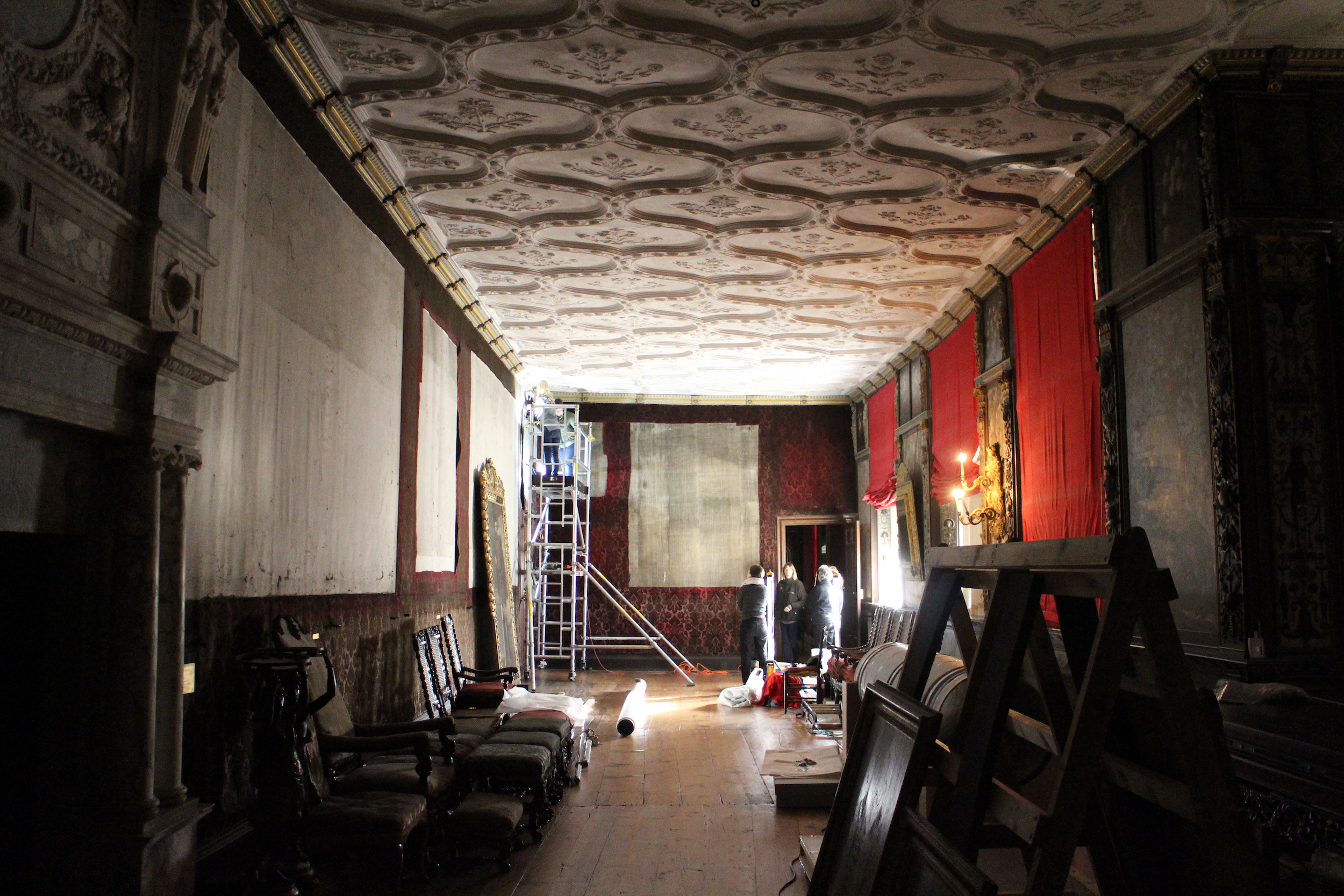

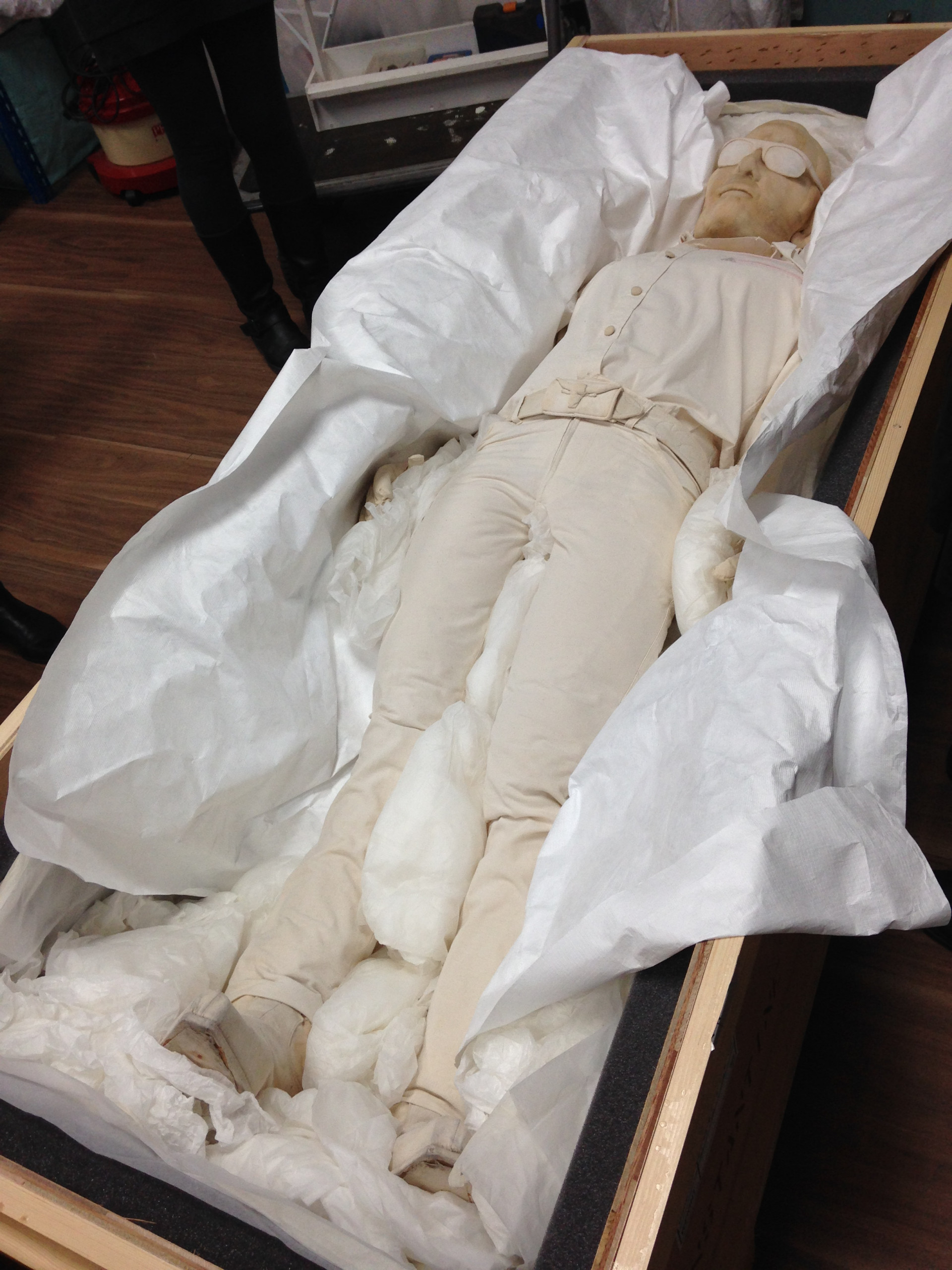
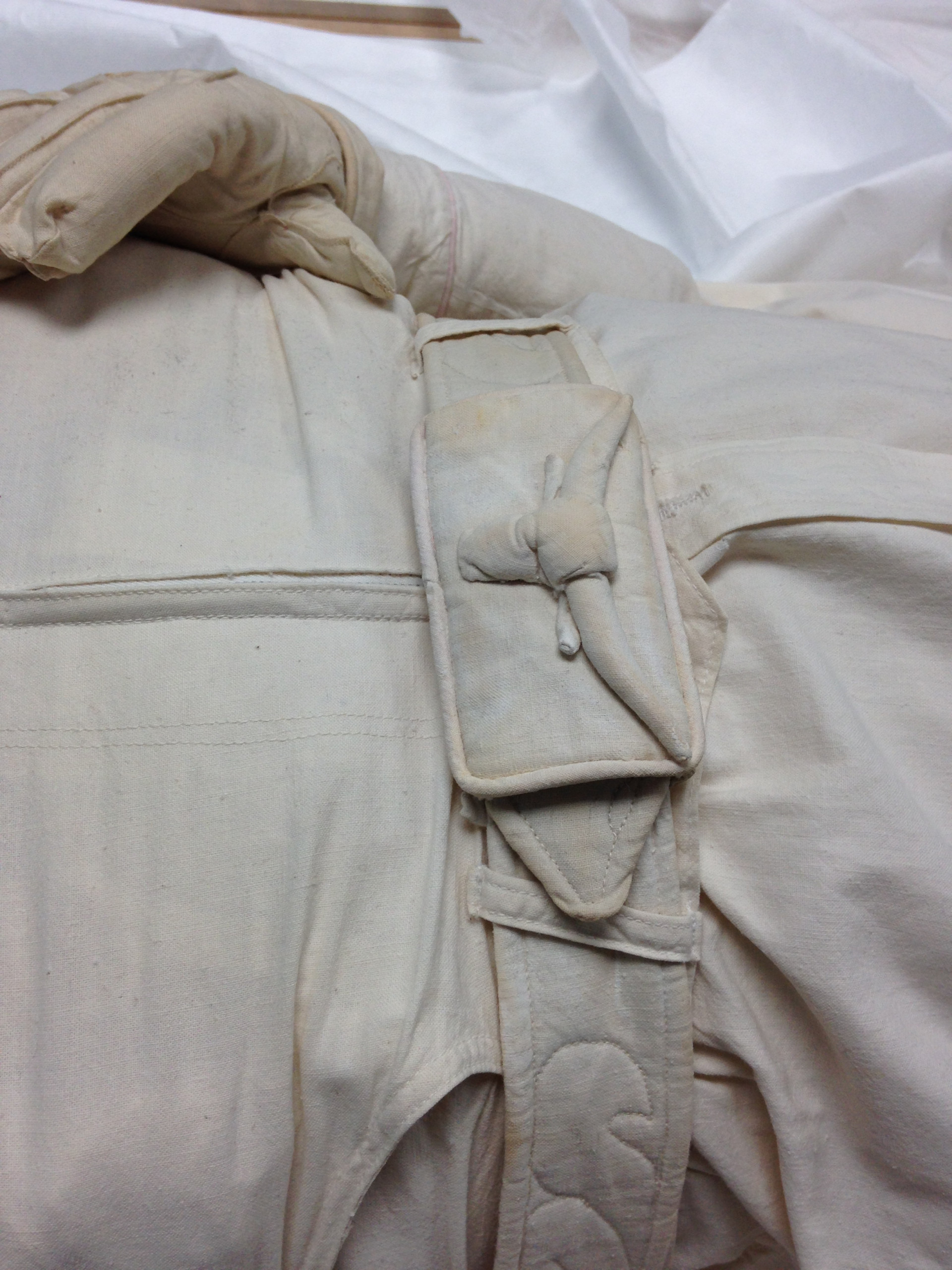
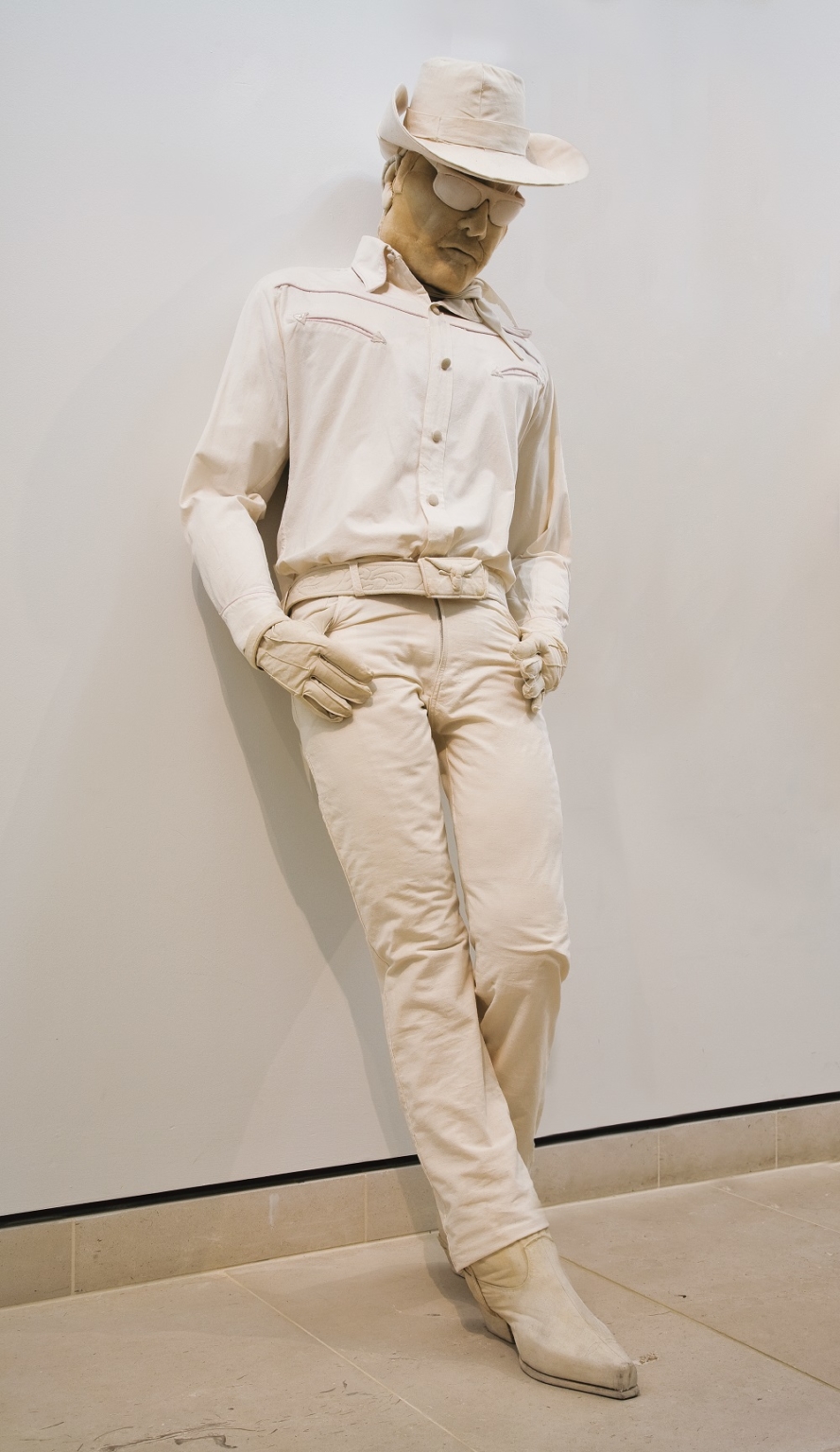


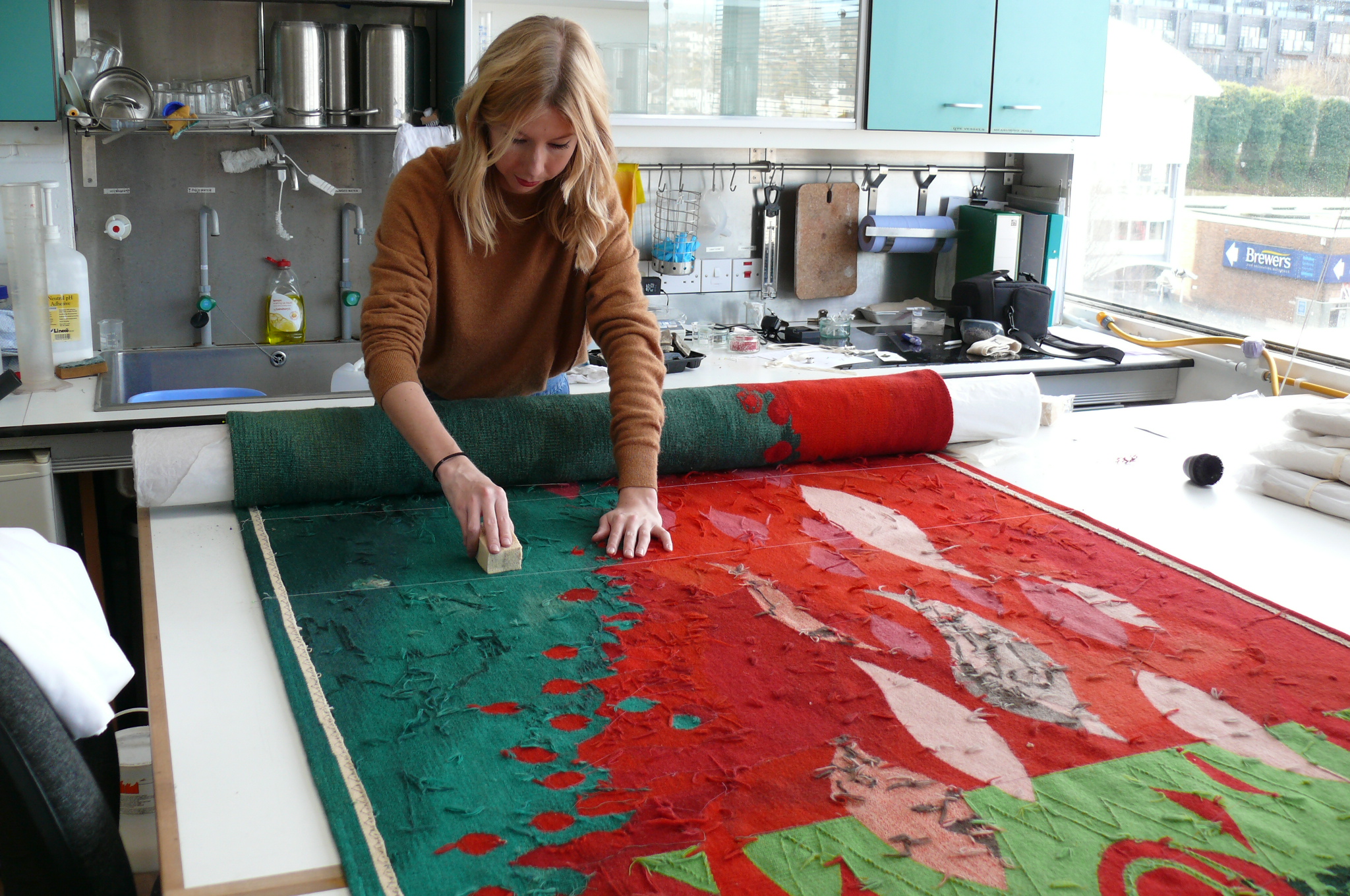


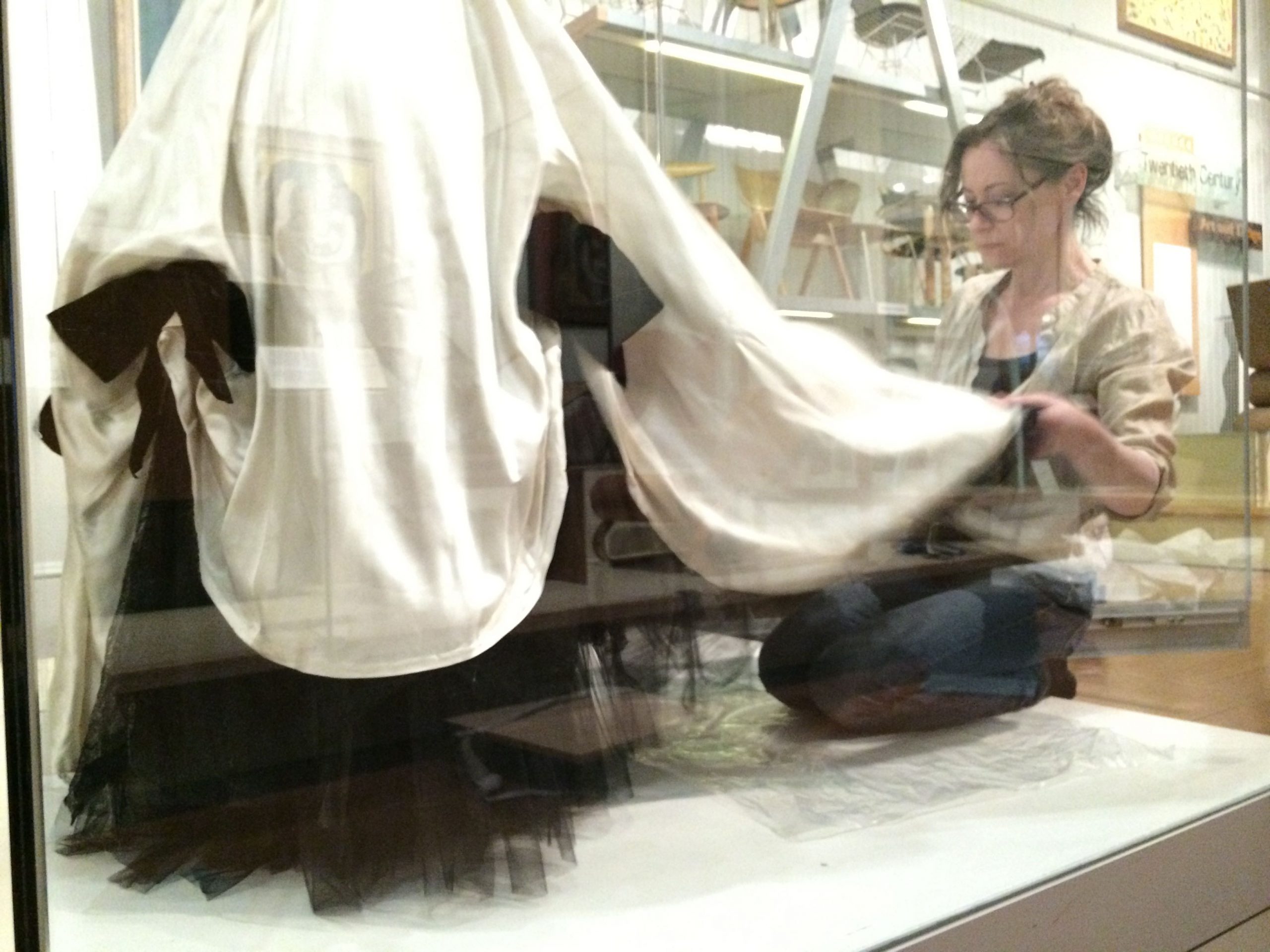



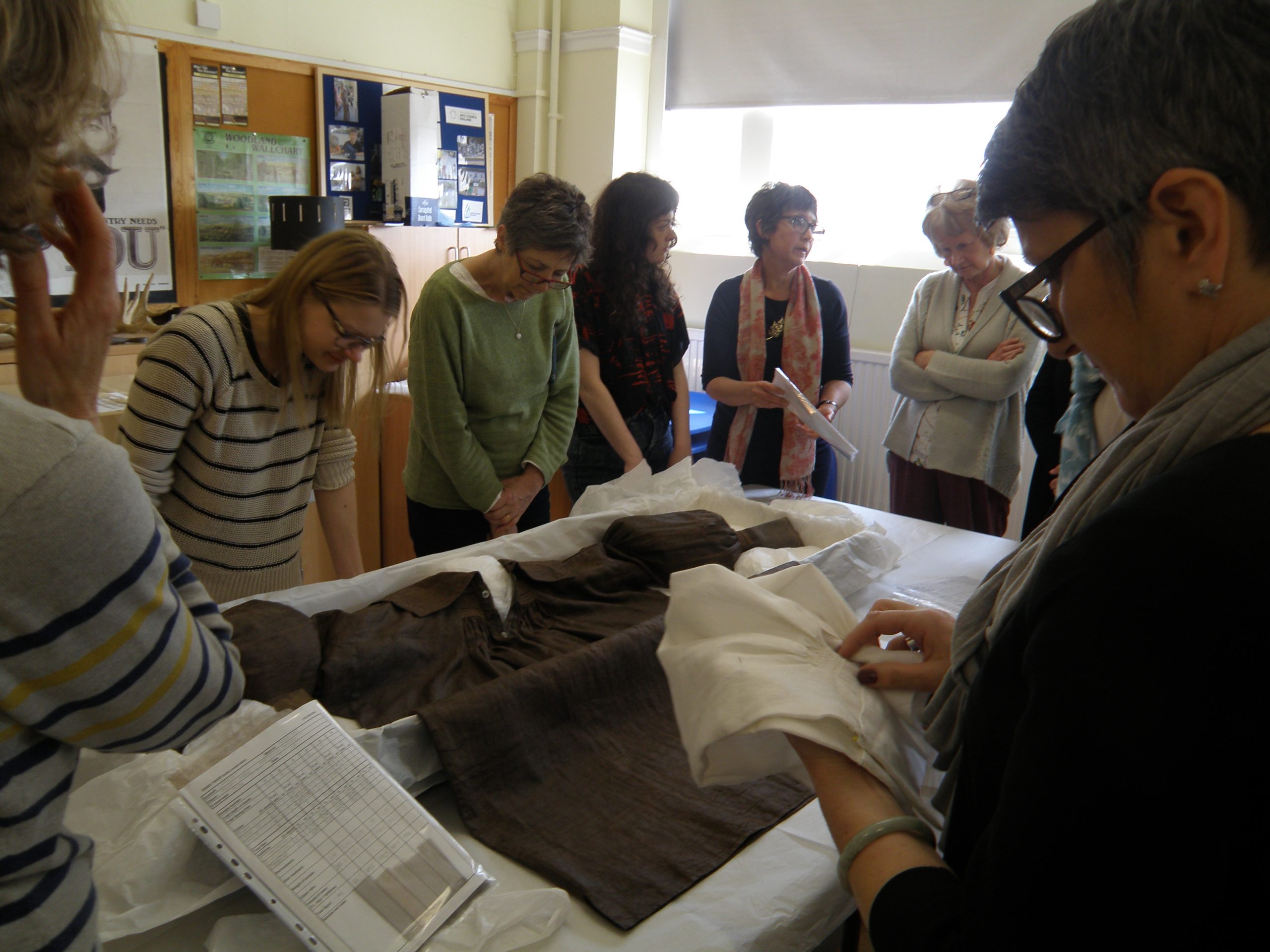


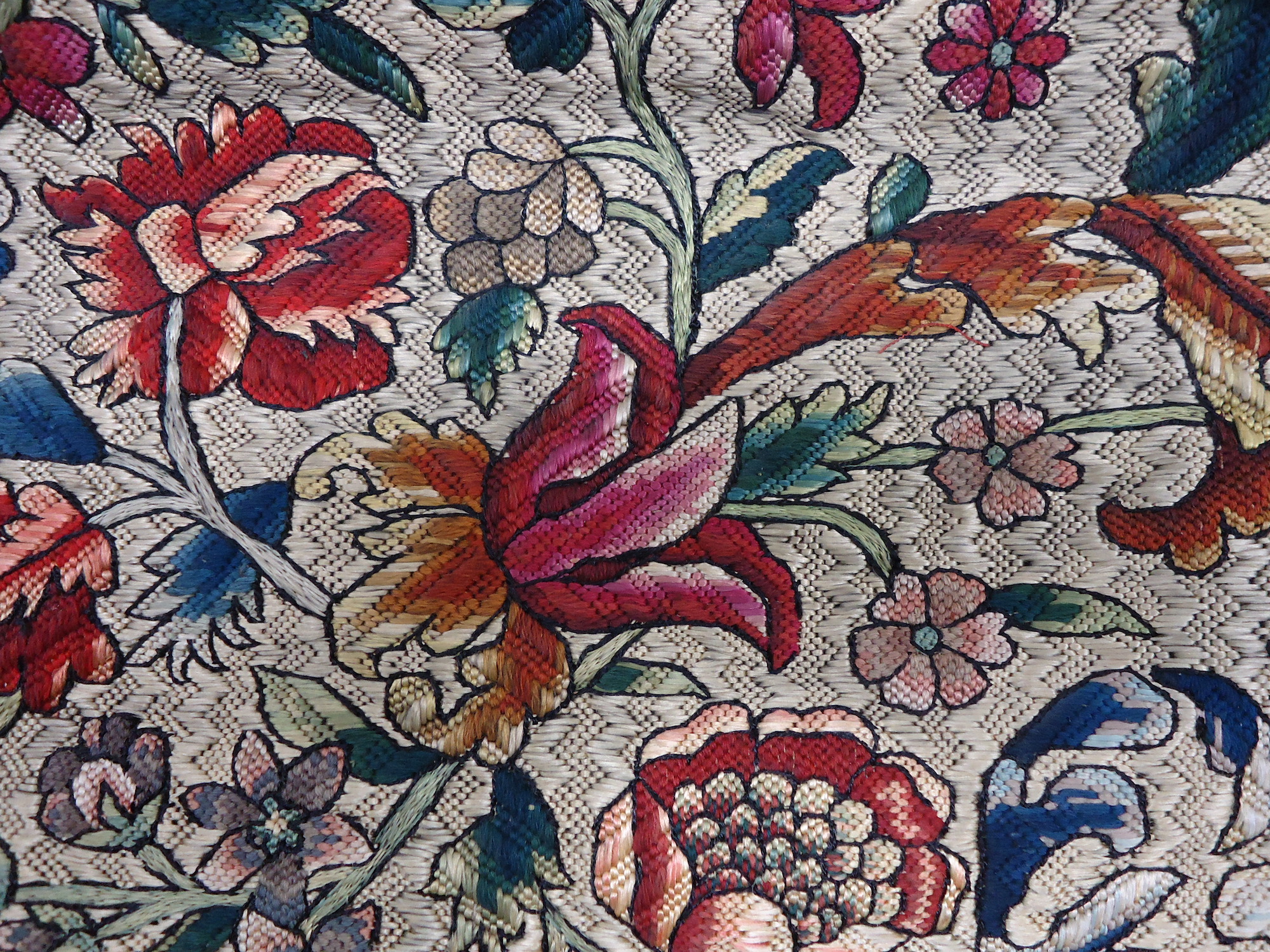




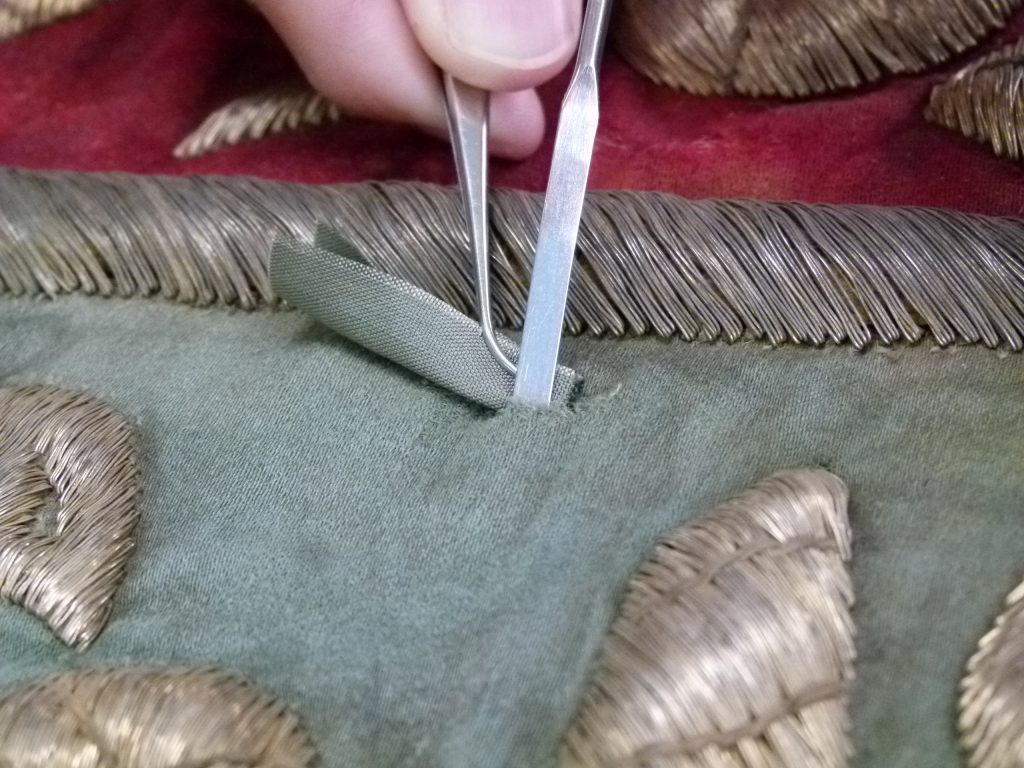
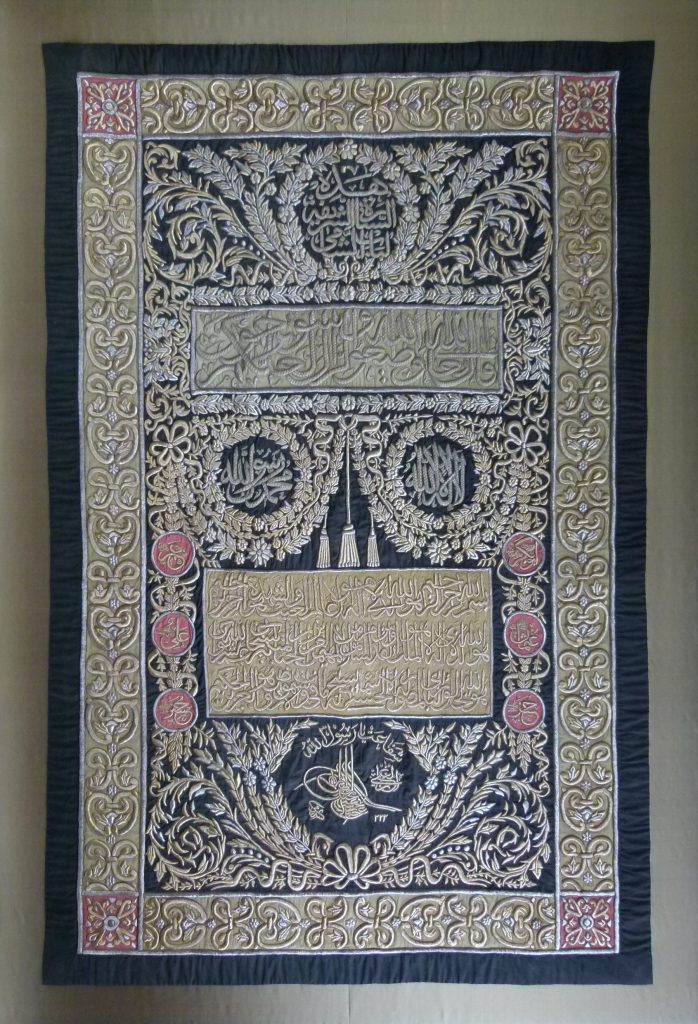

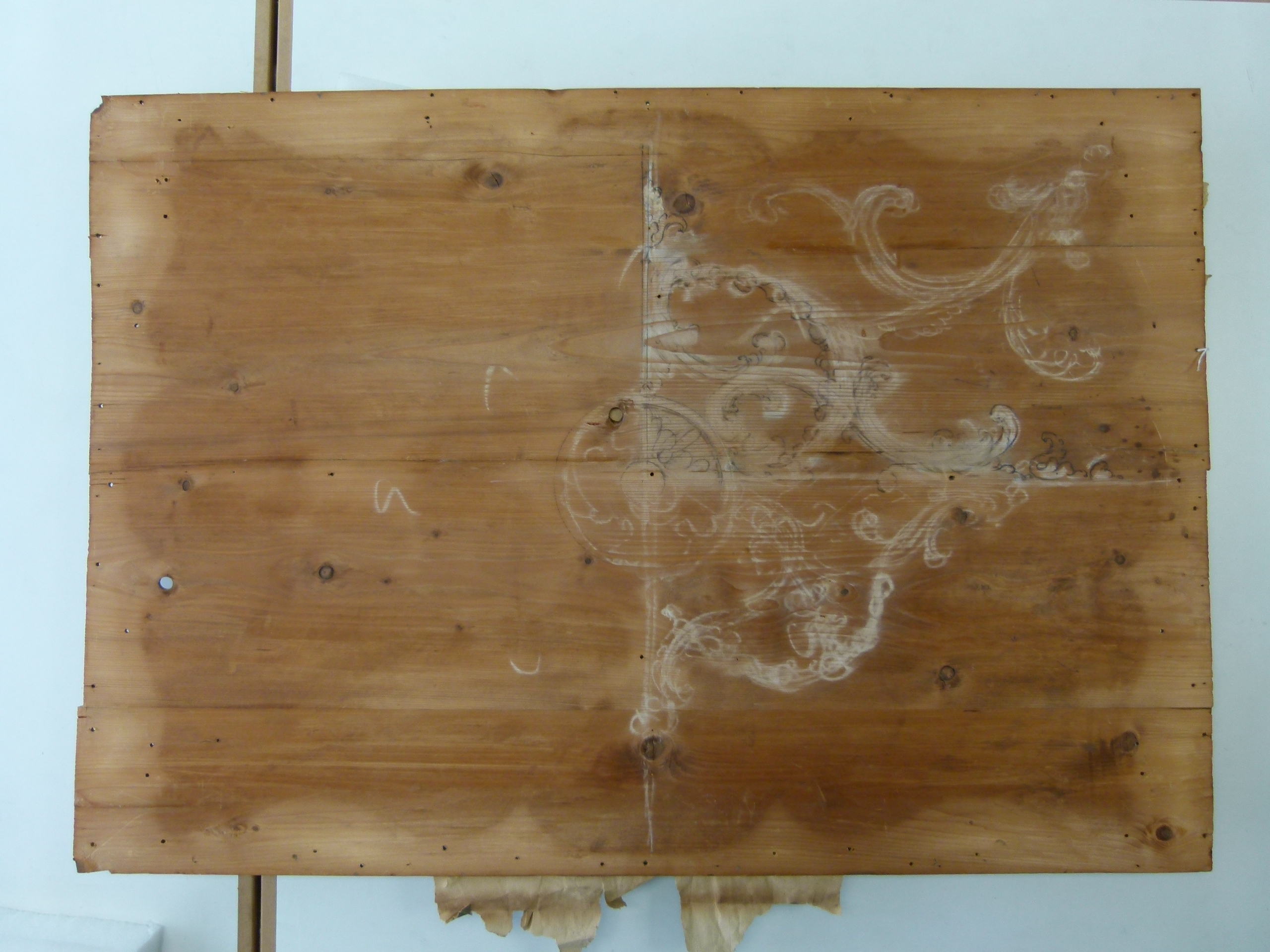
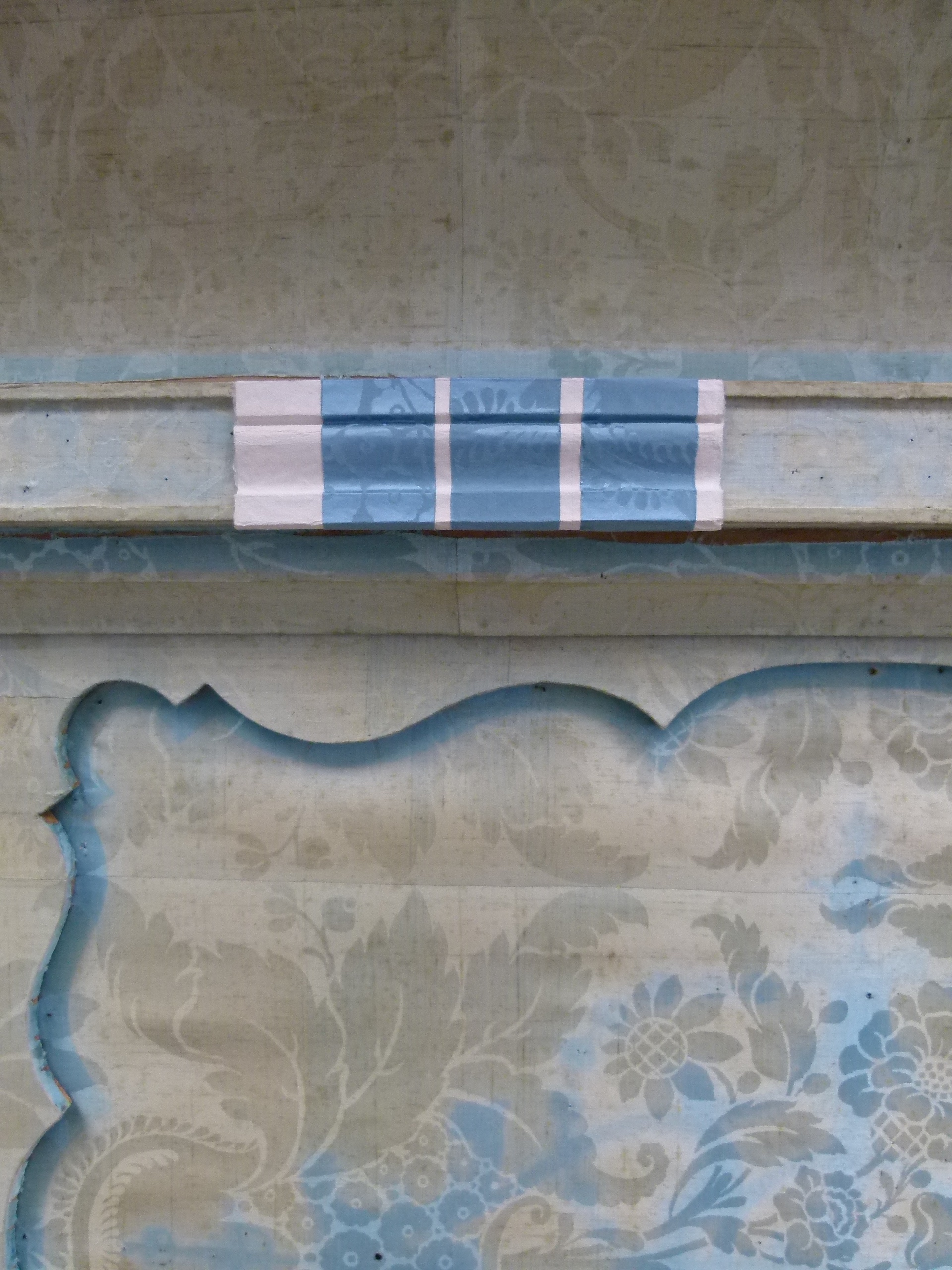
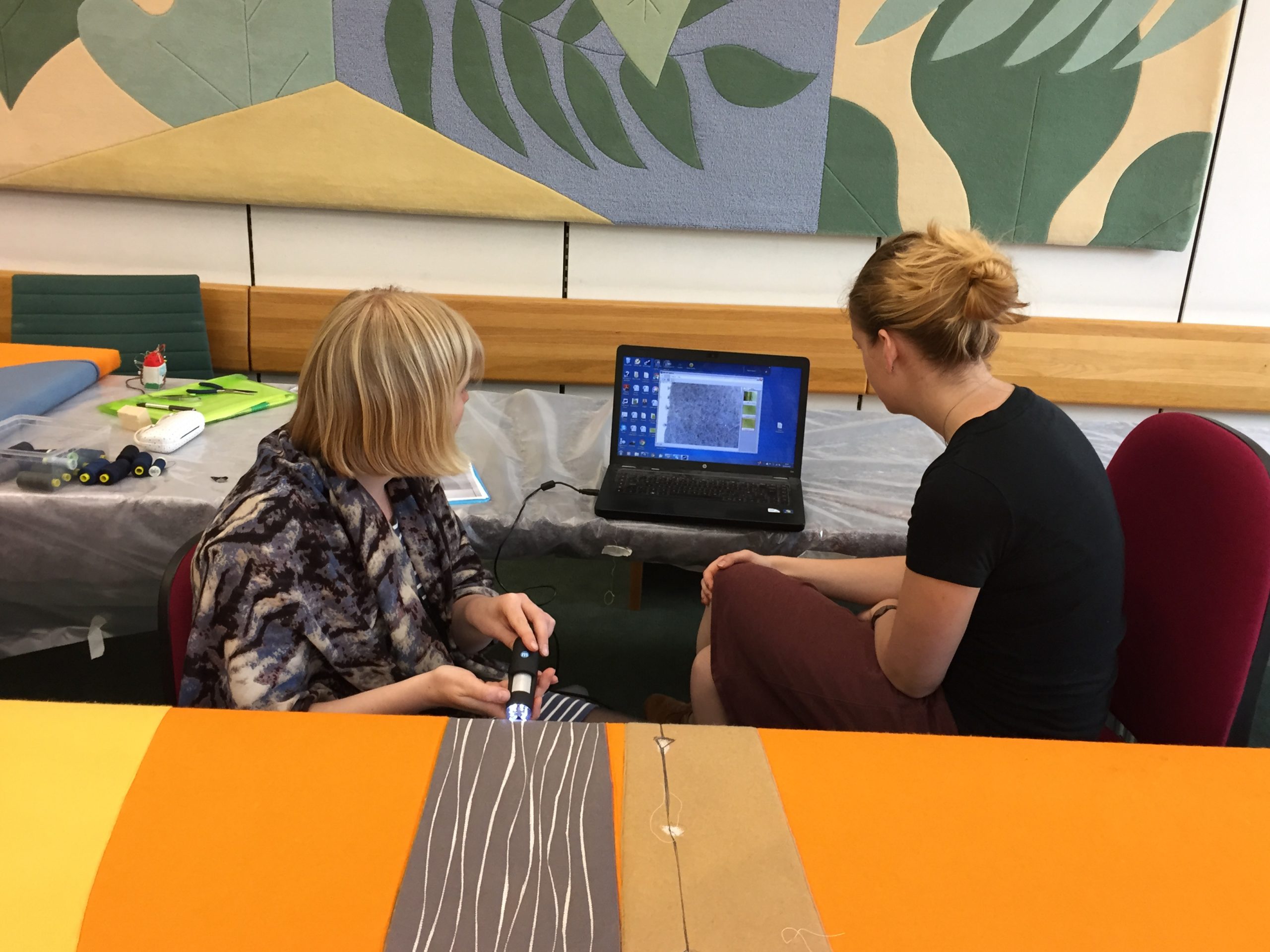
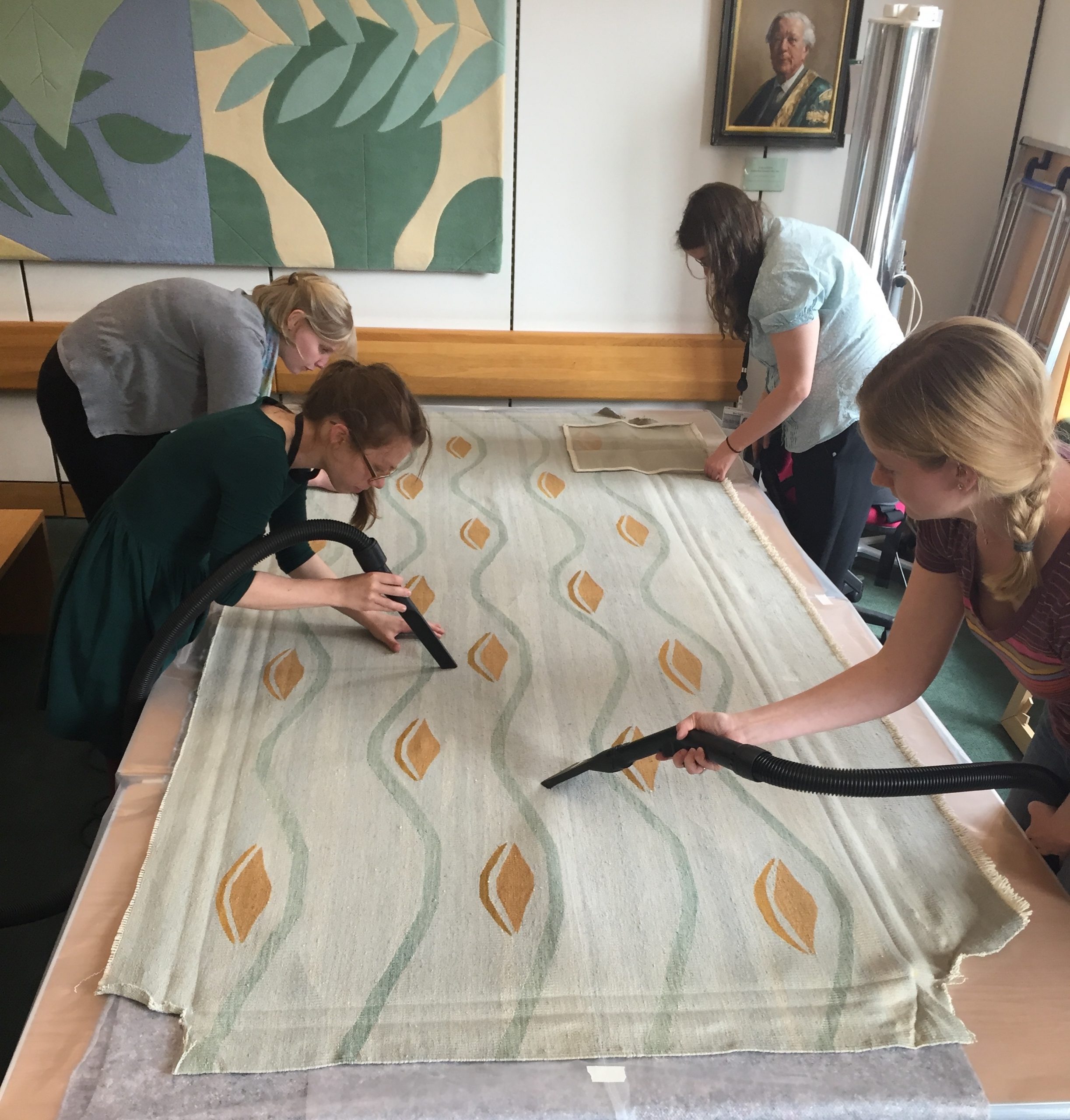

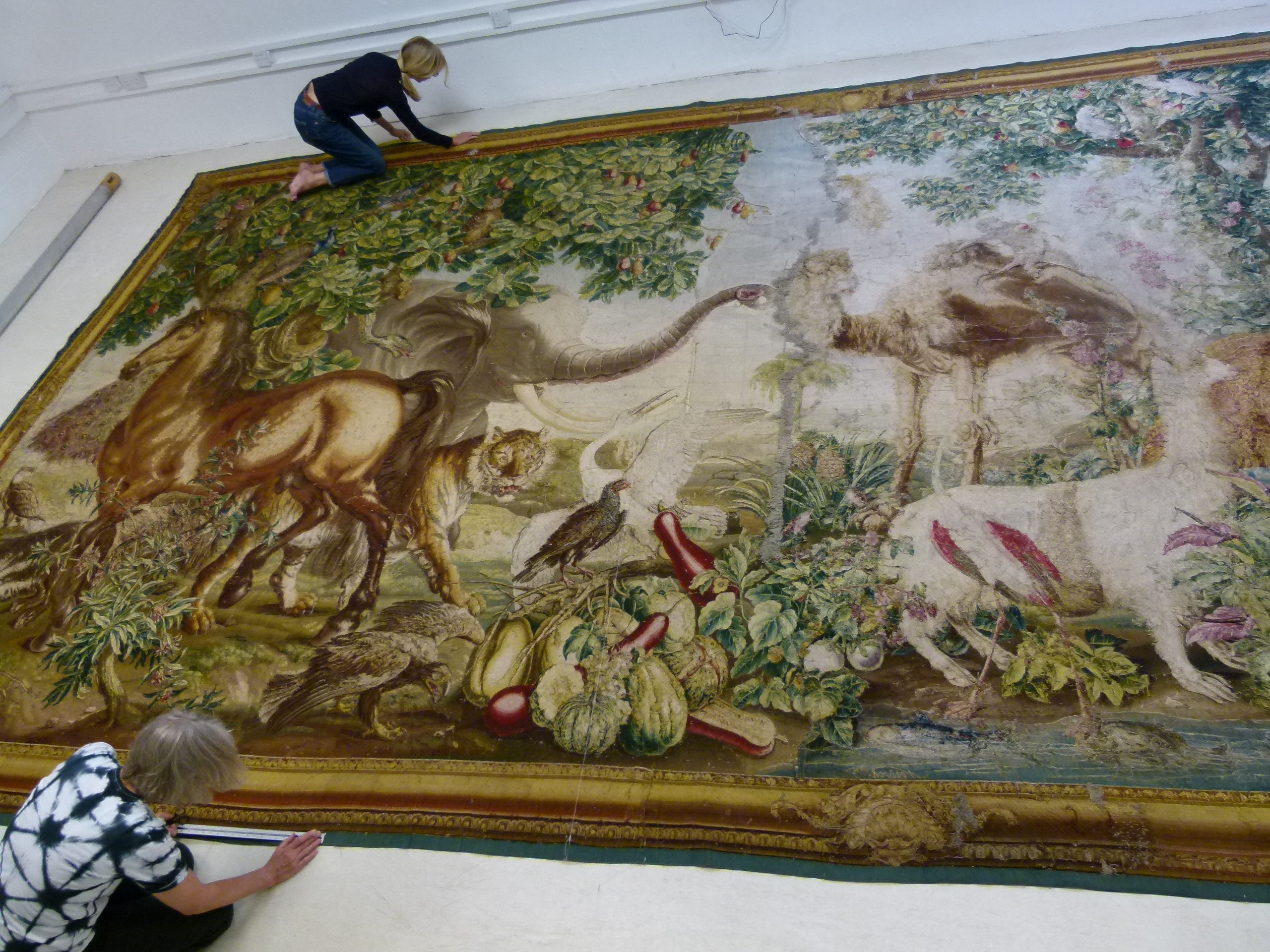

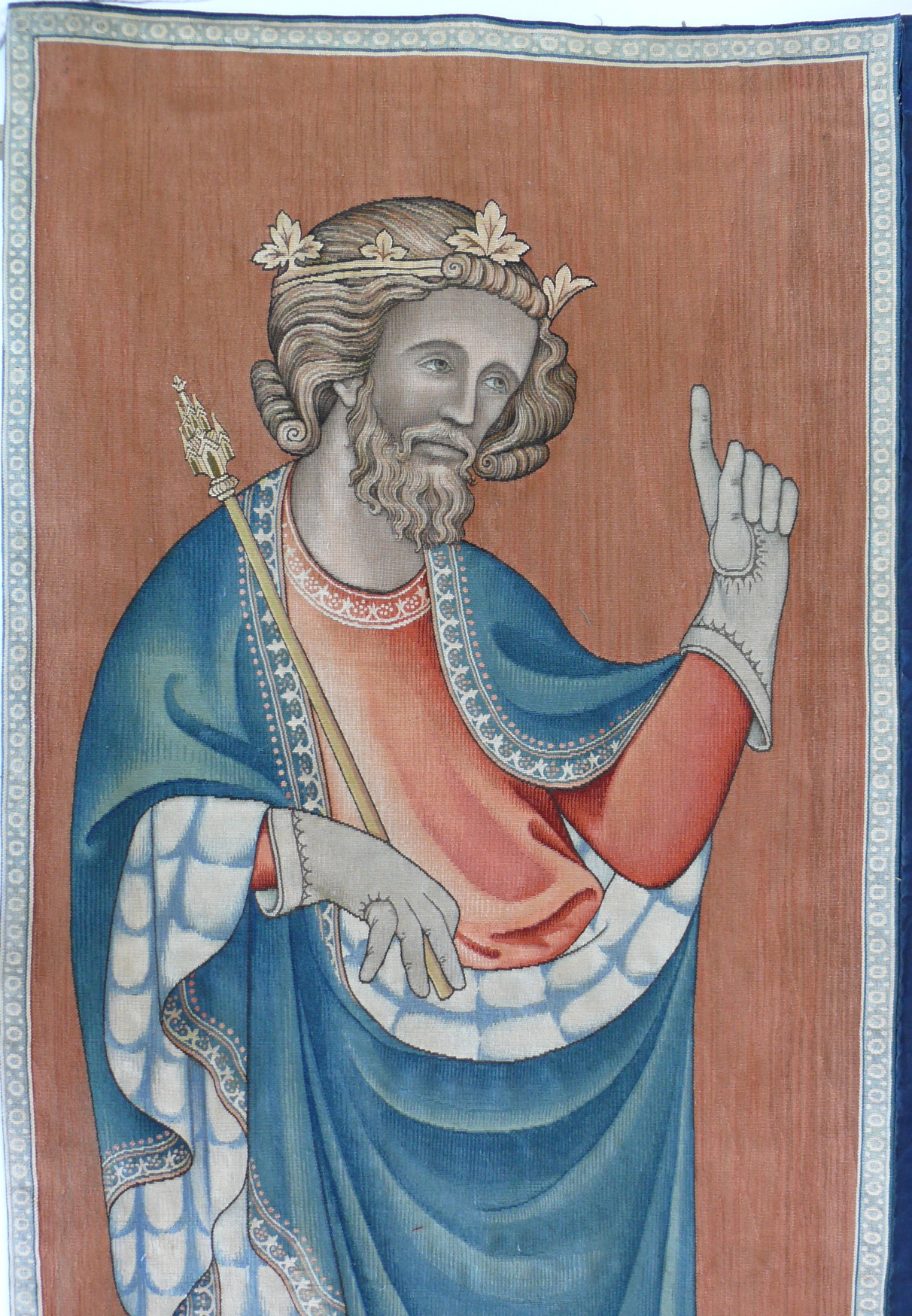

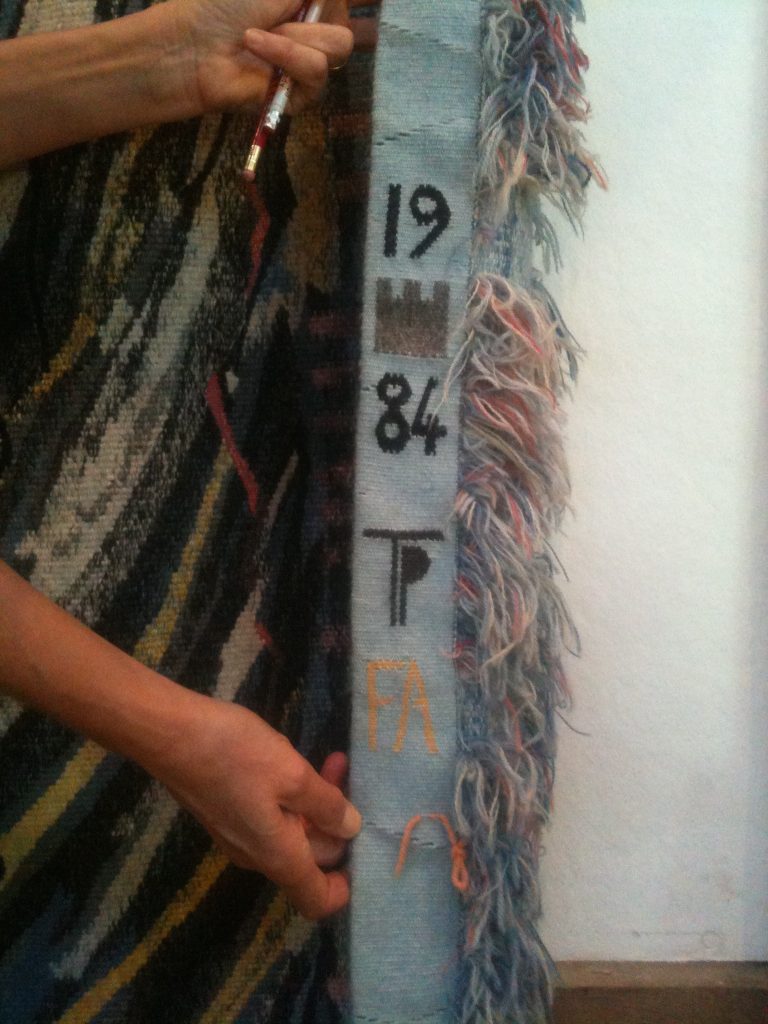

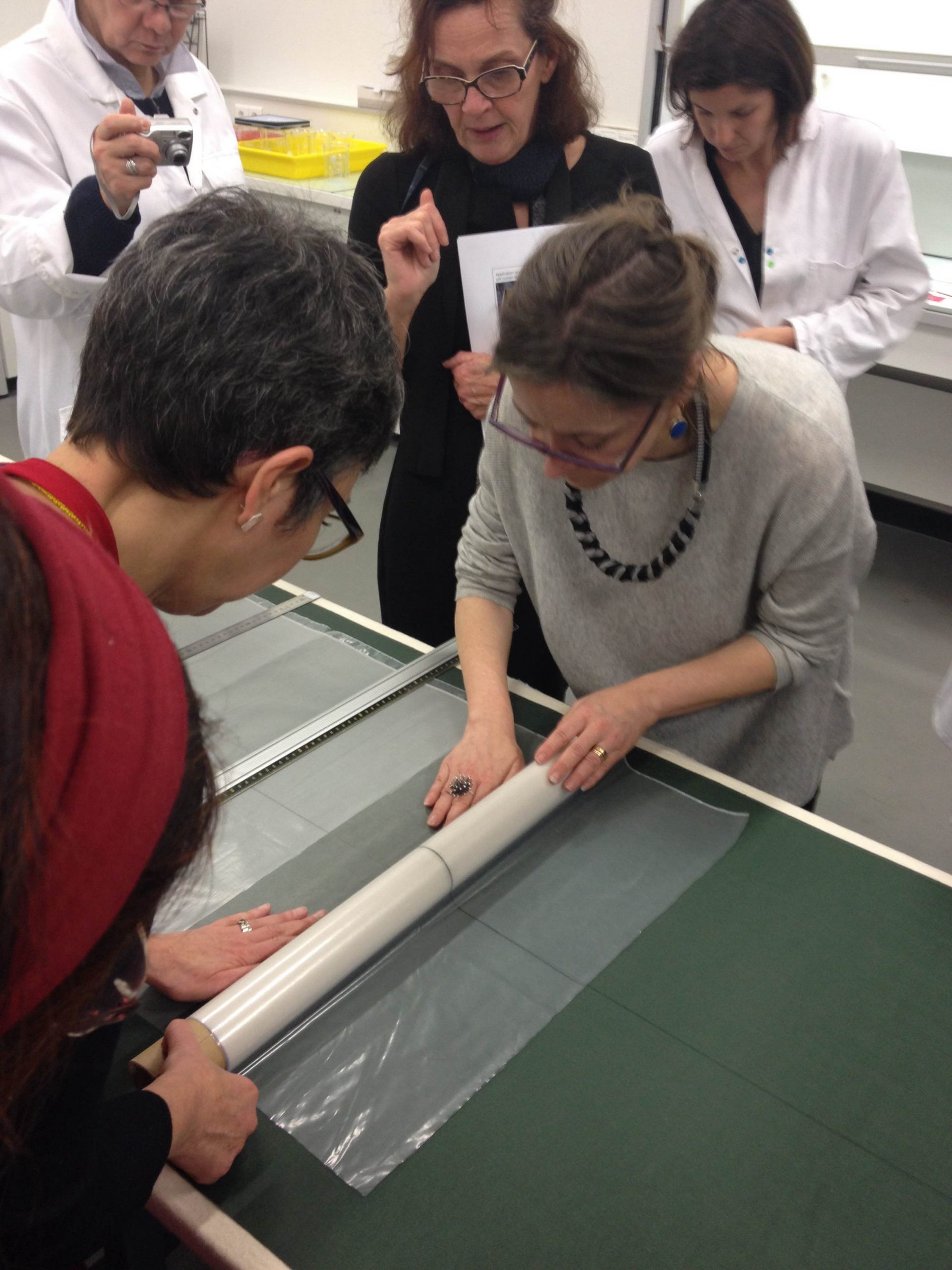
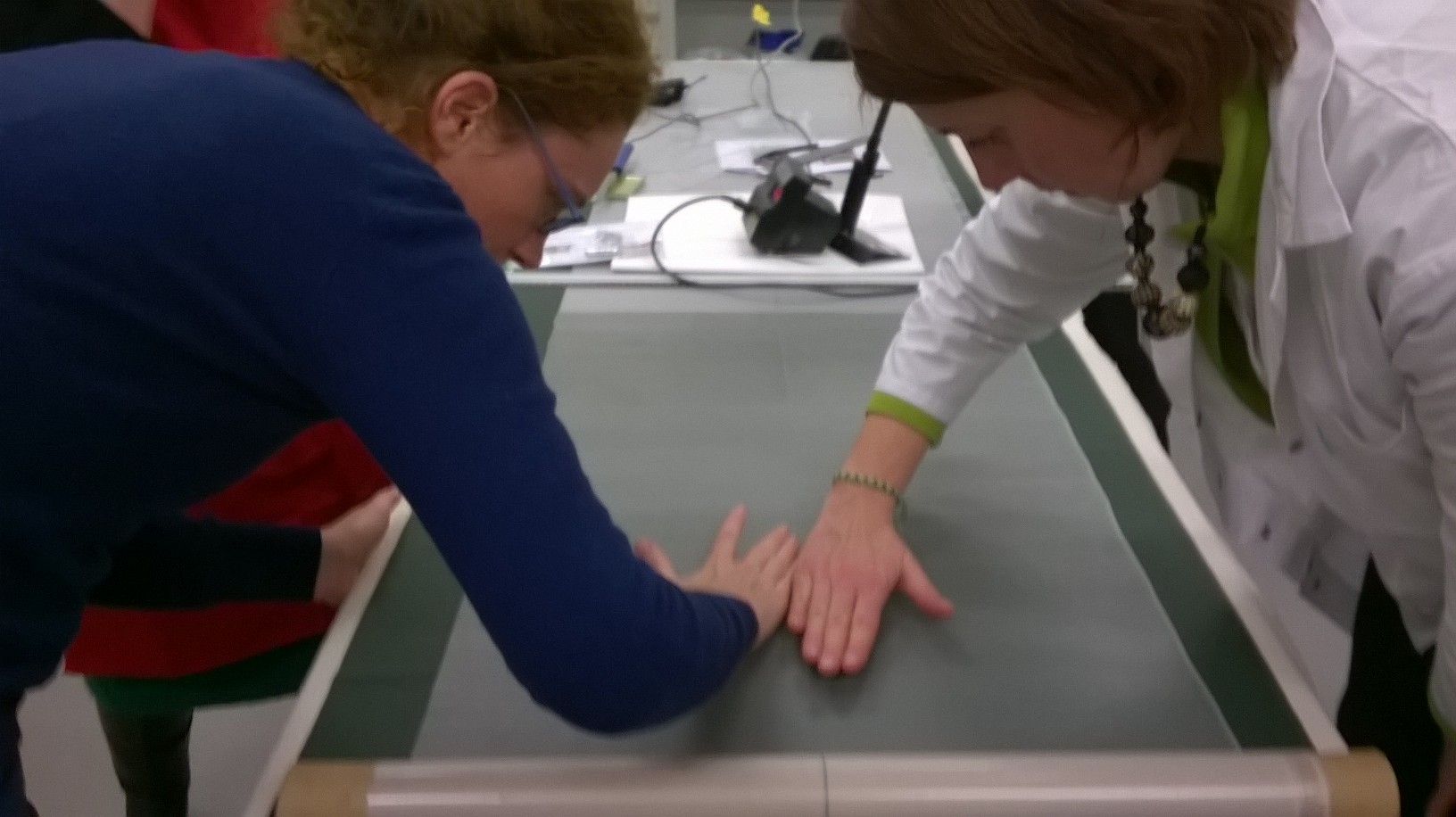

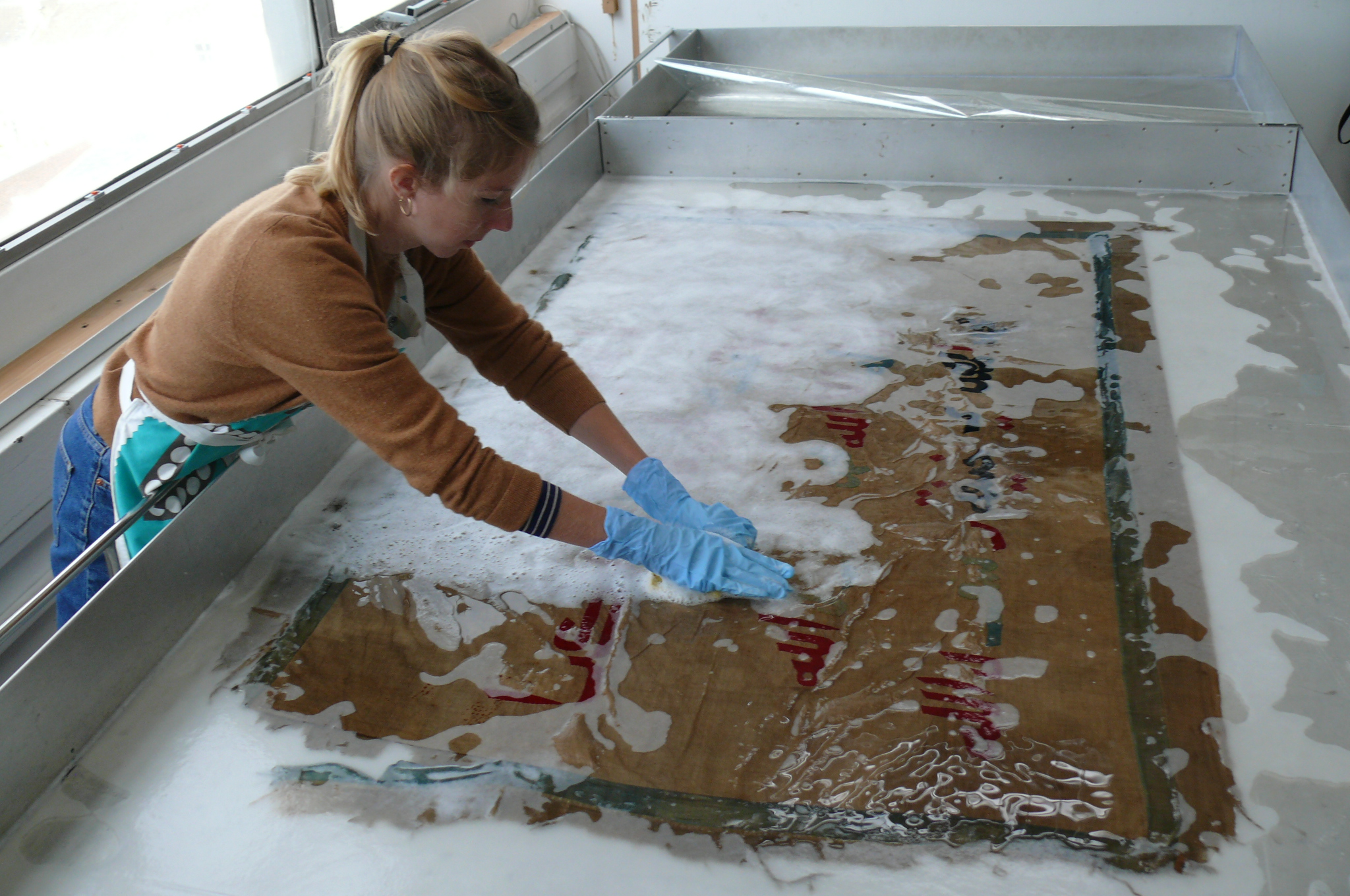
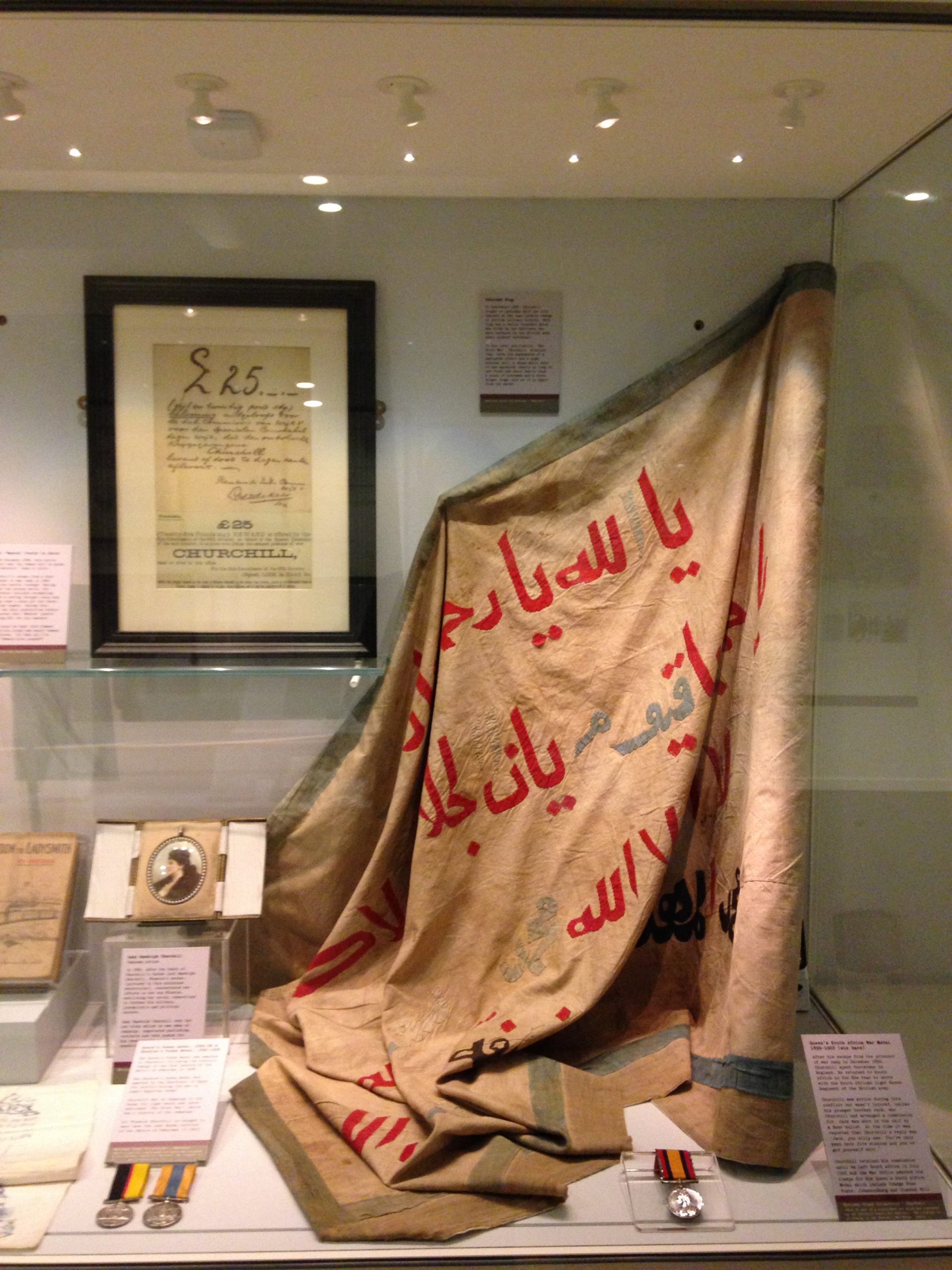



Fascinating!